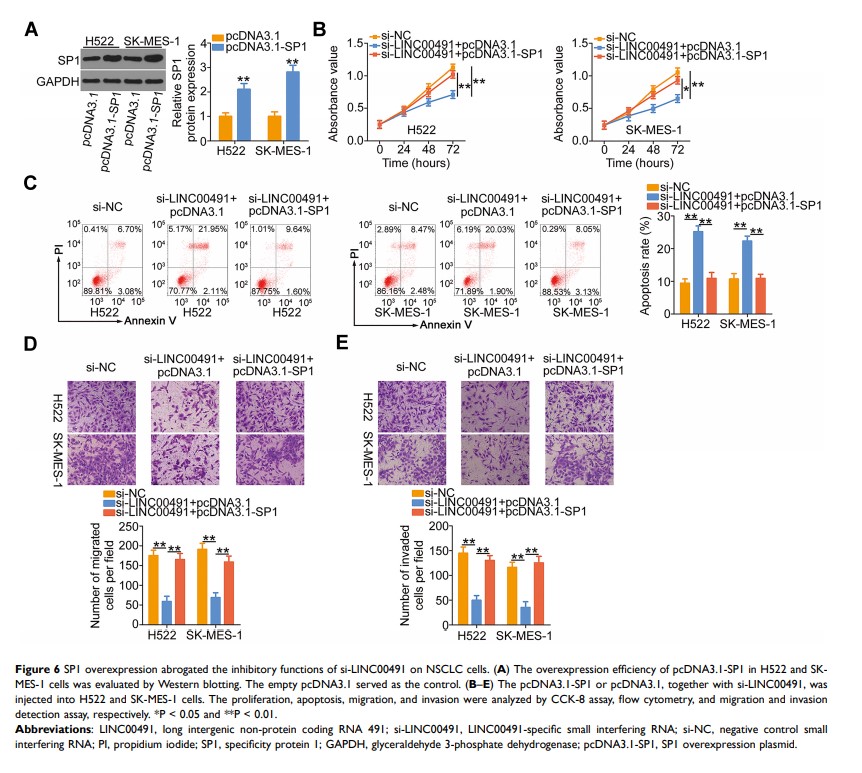9 7 8 1 6
论文已发表
注册即可获取德孚的最新动态
IF 收录期刊
- 3.3 Breast Cancer (Dove Med Press)
- 3.4 Clin Epidemiol
- 2.5 Cancer Manag Res
- 2.9 Infect Drug Resist
- 3.5 Clin Interv Aging
- 4.7 Drug Des Dev Ther
- 2.7 Int J Chronic Obstr
- 6.6 Int J Nanomed
- 2.5 Int J Women's Health
- 2.5 Neuropsych Dis Treat
- 2.7 OncoTargets Ther
- 2.0 Patient Prefer Adher
- 2.3 Ther Clin Risk Manag
- 2.5 J Pain Res
- 2.8 Diabet Metab Synd Ob
- 2.8 Psychol Res Behav Ma
- 3.0 Nat Sci Sleep
- 1.8 Pharmgenomics Pers Med
- 2.7 Risk Manag Healthc Policy
- 4.2 J Inflamm Res
- 2.1 Int J Gen Med
- 4.2 J Hepatocell Carcinoma
- 3.7 J Asthma Allergy
- 1.9 Clin Cosmet Investig Dermatol
- 2.7 J Multidiscip Healthc

长非编码 RNA LINC00491 通过与 microRNA-324-5p 的竞争性结合并增加特异性蛋白 1 表达来促进非小细胞肺癌的恶性肿瘤
Authors Zhang X, Zhao X, Wang Y, Xing L
Received 28 May 2020
Accepted for publication 19 July 2020
Published 6 August 2020 Volume 2020:12 Pages 6779—6793
DOI https://doi.org/10.2147/CMAR.S264681
Checked for plagiarism Yes
Review by Single anonymous peer review
Peer reviewer comments 2
Editor who approved publication: Dr Sanjeev Srivastava
Background: A long non-coding RNA termed as long intergenic non-protein coding RNA 491 (LINC00491) has been validated as an oncogene to promote cancer progression in colon adenocarcinoma. The goal of this study was to determine the expression and carcinogenic functions of LINC00491 in non-small-cell lung cancer (NSCLC). Besides, it was aimed to understand how LINC00491 affects the malignant processes of NSCLC cells.
Methods: The expression of LINC00491 in NSCLC was investigated by bioinformatic analysis and reverse transcription-quantitative PCR. After LINC00491 knockdown, cell counting kit-8 assay, flow cytometry, migration and invasion detection assays as well as nude mice xenograft assay were conducted to test the roles of LINC00491 in NSCLC cells. Two online databases, StarBase 3.0 and miRDB, were utilized to determine the putative target miRNA of LINC00491, and the prediction was subsequently confirmed by luciferase reporter assay, RNA immunoprecipitation assay, reverse transcription-quantitative PCR, Western blotting, and rescue assays.
Results: LINC00491 was overexpressed in both NSCLC tissues and cell lines. Functional investigation revealed that depleted LINC00491 facilitated cell apoptosis and decreased cell proliferation, migration, and invasion in vitro. Additionally, the downregulation of LINC00491 impaired NSCLC cell tumor growth in vivo. Mechanistically, LINC00491 functioned as a competing endogenous RNA by sponging microRNA-324-5p (miR-324-5p) in NSCLC cells. miR-324-5p was weakly expressed in NSCLC and exerted tumor-suppressing actions during cancer progression. Furthermore, specificity protein 1 (SP1) was validated as the direct target of miR-324-5p in NSCLC and was under the regulation of LINC00491 via sponging miR-324-5p. Rescue experiments reconfirmed that miR-324-5p inhibition and SP1 overexpression both abrogated the suppressive roles of LINC00491 deficiency in NSCLC cells.
Conclusion: LINC00491 promoted the oncogenicity of NSCLC via serving as a miR-324-5p sponge, which further upregulated the expression of SP1. The LINC00491/miR-324-5p/SP1 pathway disclosed a new mechanism of NSCLC pathogenesis and may provide effective targets for better NSCLC treatment.
Keywords: non-small-cell lung cancer management, long non-coding RNA, ceRNA hypothesis
